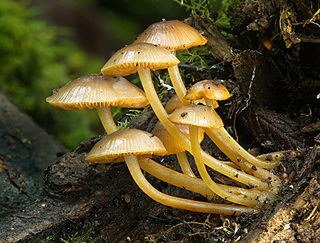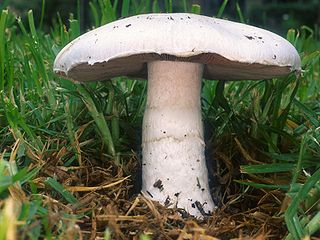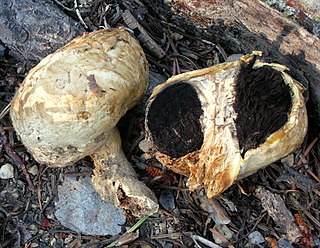
Mycology is the branch of biology concerned with the study of fungi, including their taxonomy, genetics, biochemical properties, and use by humans. Fungi can be a source of tinder, food, traditional medicine, as well as entheogens, poison, and infection.

The Agaricales are an order of fungi in the division Basidiomycota. As originally conceived, the order contained all the agarics, but subsequent research has shown that not all agarics are closely related and some belong in other orders, such as the Russulales and Boletales. Conversely, DNA research has also shown that many non-agarics, including some of the clavarioid fungi and gasteroid fungi belong within the Agaricales. The order has 46 extant families, more than 400 genera, and over 25,000 described species, along with six extinct genera known only from the fossil record. Species in the Agaricales range from the familiar Agaricus bisporus and the deadly Amanita virosa to the coral-like Clavaria zollingeri and bracket-like Fistulina hepatica.

Agaricus bisporus, commonly known as the cultivated mushroom, is a basidiomycete mushroom native to grasslands in Eurasia and North America. It has two color states while immature – white and brown – both of which have various names, with additional names for the mature state, including portobello.

The Agaricaceae are a family of basidiomycete fungi and include the genus Agaricus, as well as basidiomycetes previously classified in the families Tulostomataceae, Lepiotaceae, and Lycoperdaceae.

Agaricus is a genus of mushroom-forming fungi containing both edible and poisonous species, with over 400 members worldwide and possibly again as many disputed or newly-discovered species. The genus includes the common ("button") mushroom and the field mushroom, the dominant cultivated mushrooms of the West.

An agaric is a type of fungus fruiting body characterized by the presence of a pileus (cap) that is clearly differentiated from the stipe (stalk), with lamellae (gills) on the underside of the pileus. In the UK, agarics are called "mushrooms" or "toadstools". In North America they are typically called "gilled mushrooms". "Agaric" can also refer to a basidiomycete species characterized by an agaric-type fruiting body.

Agaricus subrufescens is a species of mushroom, commonly known as almond mushroom, almond agaricus, mushroom of the sun, God's mushroom, mushroom of life, royal sun agaricus, jisongrong, or himematsutake. A. subrufescens is edible, with a somewhat sweet taste and a fragrance of almonds.

Agaricus campestris is a widely eaten gilled mushroom closely related to the cultivated A. bisporus. A. campestris is commonly known as the field mushroom or, in North America, meadow mushroom.

Macrolepiota is a genus of white spored, gilled mushrooms of the family Agaricaceae. The best-known member is the parasol mushroom (M. procera). The widespread genus contains about 40 species.

Gymnopilus luteofolius, known as the yellow-gilled gymnopilus, is a large and widely distributed mushroom that grows in dense clusters on dead hardwoods and conifers. It grows in late July to November in the east and in the winter on the west coast of North America. It has a rusty orange spore print and a bitter taste.

Gymnopilus purpuratus is a species of agaric fungus in the family Hymenogastraceae. It grows in clusters on dead wood, tree stumps and wood chip mulch. It is widely distributed and has been recorded in Argentina, Australia, Chile, New Zealand, the UK and Germany. It has a broadly convex cap covered in small dry reddish-brown scales, a stout yellow stem beneath reddish brown, wine-red to purple vertical fibres, and a thick rusty orange spore print.

Agaritine is an aromatic hydrazine-derivative mycotoxin in mushroom species of the genus Agaricus. It is an α-aminoacid and a derivative of phenylhydrazine.
Julius Schäffer was a German mycologist. His contributions include studies on the Agaricales, especially the genus Russula, about which he wrote a monograph in 1933. Later, he revised the genus in the series Die Pilze Mitteleuropas (1926–1967); his notes were published posthumously by his wife Liesel in 1952 with the help of other mycologists. The work was considered the "authoritative treatment of the group for Central Europe". One of the Russula species that was first described in this publication was R. laeta. Schäffer developed a chemical test to help with the identification of Agaricus species. A positive reaction of Schaeffer's test, which uses the reaction of aniline and nitric acid on the surface of the mushroom, is indicated by an orange to red color; it is characteristic of species in the section Flavescentes. The compounds responsible for the reaction were named schaefferal A and B to honor Schäffer.

Agaricus inapertus is a species of secotioid fungus in the genus Agaricus. It was first described by American mycologists Rolf Singer and Alexander H. Smith in 1958 as Endoptychum depressum. Molecular analysis later proved it to be aligned with Agaricus, and it was formally transferred in a 2003 publication.
Charaxes tectonis, the mountain silver-barred charaxes, is a butterfly in the family Nymphalidae. It is found in Nigeria and Cameroon. The habitat consists of sub-montane and montane forests.

Macrolepiota mastoidea is a species of mushroom producing fungus in the family Agaricaceae.

Agaricus bresadolanus is a species of fungus in the genus Agaricus. Its spores are ellipsoid and lack a germ pore, with dimensions of 5.5–7.5 by 4.0–5.0 µm.
Nepenthes nebularum is a tropical pitcher plant native to southeastern Mindanao in the Philippines. The species was described by Geoff Mansell, owner of Exotica Plants, and Filipino botanist Wally Suarez. It has so far been recorded with certainty from only two mountains (Mount Hafas & undisclosed location, where it grows in submontane mossy forest at an altitude of up to 1800 m above sea level. It has been found in close proximity to N. copelandii, N. truncata, and a taxon matching the description of N. cornuta.

Macrolepiota zeyheri is a species of mushroom producing fungus in the family Agaricaceae. In the Kilendu dialect it is known as djilo and in the Kilur dialect it is called n'volo mighom.













